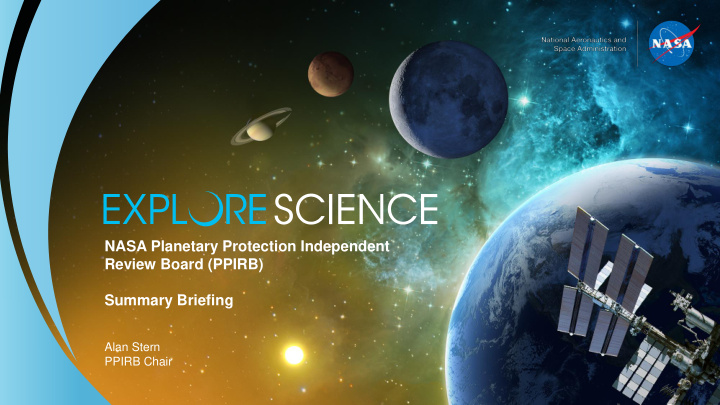



NASA Planetary Protection Independent Review Board (PPIRB) Summary Briefing Alan Stern PPIRB Chair
PPIRB Background ➢ PPIRB Term: July-September 2019 ➢ PPIRB Membership: Planetary scientists, biologists, private and civil sector space reps. ➢ Charter Summary : “An assessment to include analysis of the scientific, engineering, industrial, legal, and program management aspects of planetary protection.” ➢ Meetings/Telecons: 4 in person multi-day meetings; 11 working telecons. ➢ Report: Reviewed within NASA prior to delivery. Released 18 Oct 2019. ➢ Next Step: NAS Review. 2
Findings and Recommendations Overview Approximately 80 Findings and Recommendations, including: ➢ Clarifying and Streamlining PP Processes within NASA ➢ Advancing PP Protocols with More Modern Technology ➢ Reducing PP Burdens on Missions ➢ Advancing PP Policies for Private Sector Missions Sample Topics in PPIRB report: ➢ General/Overarching ➢ PP Categorization ➢ Human Spaceflight ➢ Private Sector Initiatives and Missions ➢ Robotic Mars Sample Return ➢ Ocean Worlds Exploration 3
Example Findings & Recs: PP Evolution Major Finding: The context in which PP is conducted is profoundly and rapidly changing … The PPIRB findings and recommendations presented in this report apply to the current era and generally are made with a 3-5 year horizon in mind. Major Recommendation: NASA should reassess its PP guidelines at least twice per decade with an IRB-like body. Major Recommendation: NASA should establish a standing forum for the discussion and resolution of emergent PP issues that includes input from government, private sector, and perhaps even non-US private sector enterprises. 4
Example Findings & Recs: Categorization Major Recommendation : NASA should study how much of the Moon’s surface and subsurface could be designated PP Category I versus Category II. Major Recommendation: NASA should reconsider how much of the Martian surface and subsurface could be Category II vs. IV. 5
Example Findings & Recs: Mars Major Finding: Planning for a Mars Sample Receiving Facility (MSRF) should be accelerated, and should be kept as pragmatic as possible so as not to unduly drive the cost or schedule of MSR. Major Finding: PP planning for human missions to Mars and the communication of those plans to the public are presently immature. Major Recommendation: NASA should begin, sooner rather than later, preparing for the public communication of all aspects of PP planning for human missions to Mars, and should pay special attention to public PP concerns, similarly to NASA’s proactive treatment of NASA missions involving radioisotope power systems. 6
with us
Recommend
More recommend